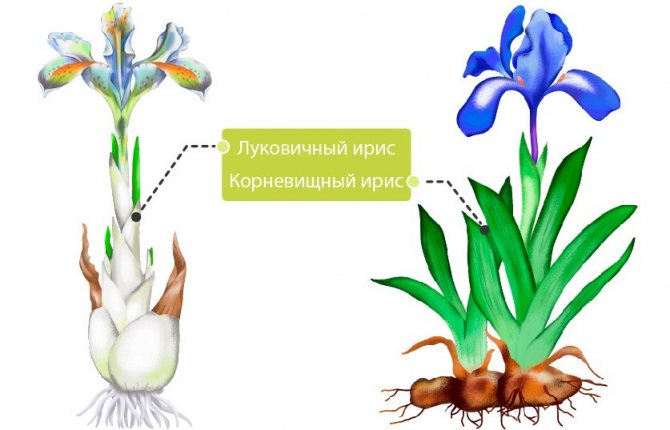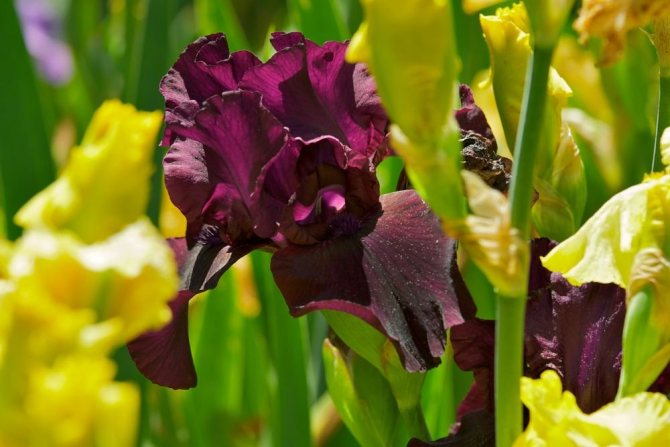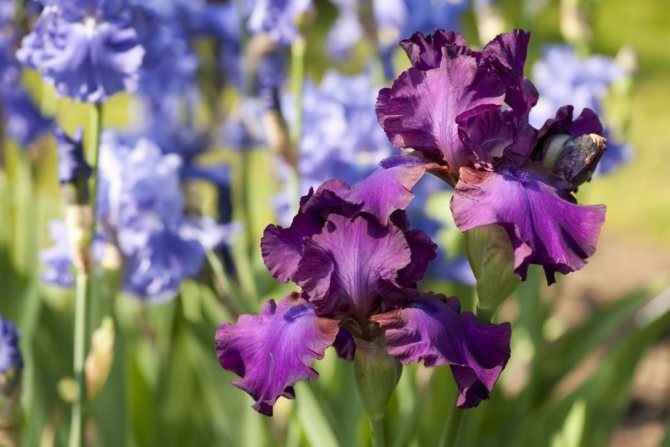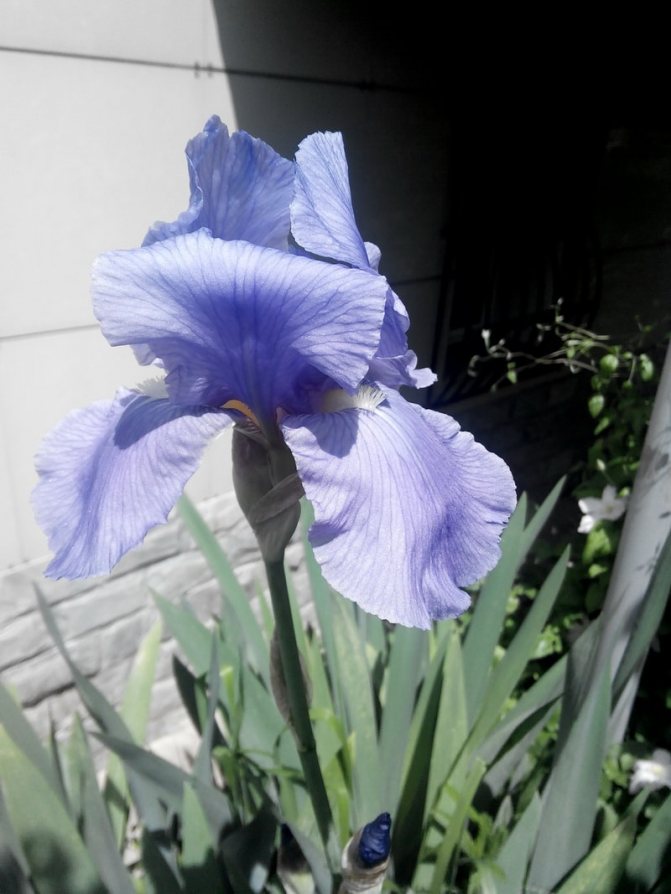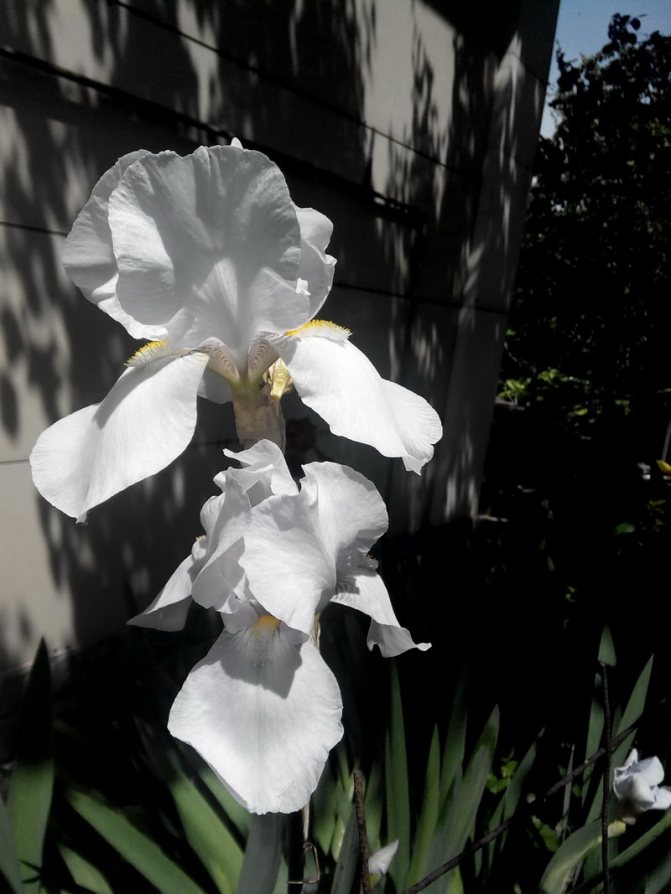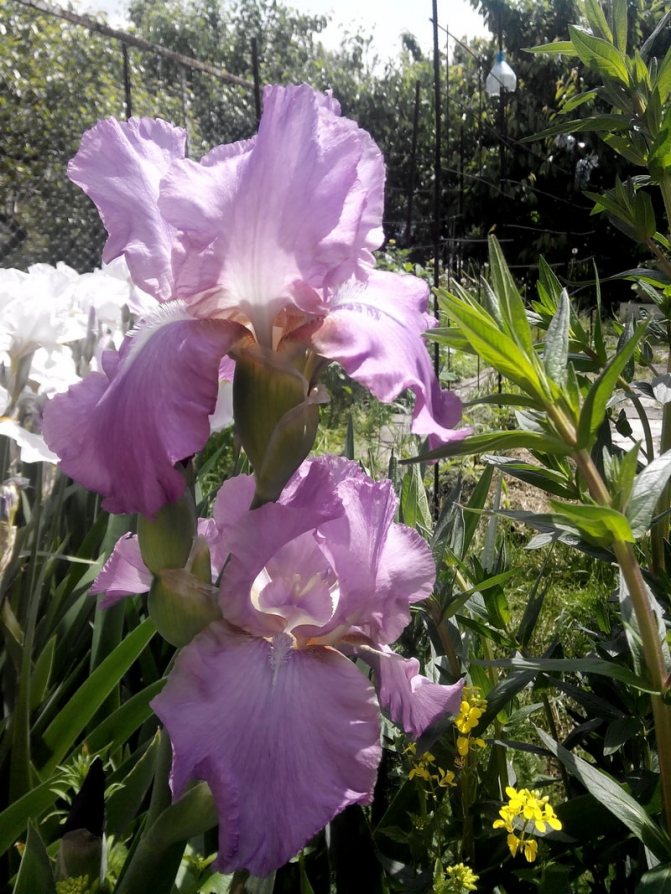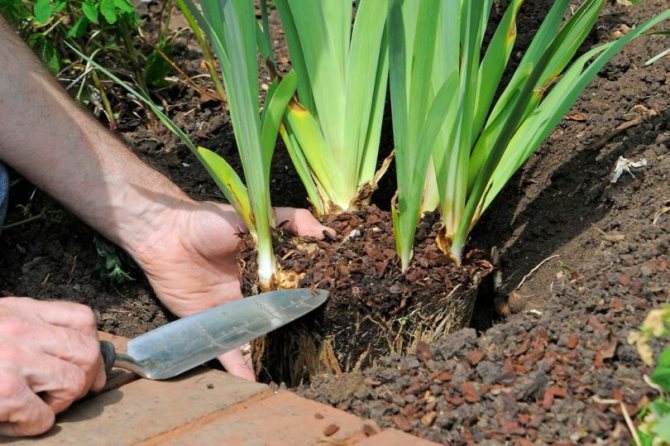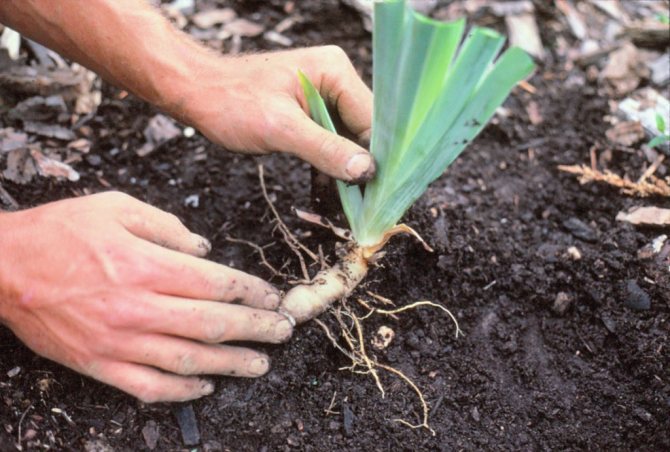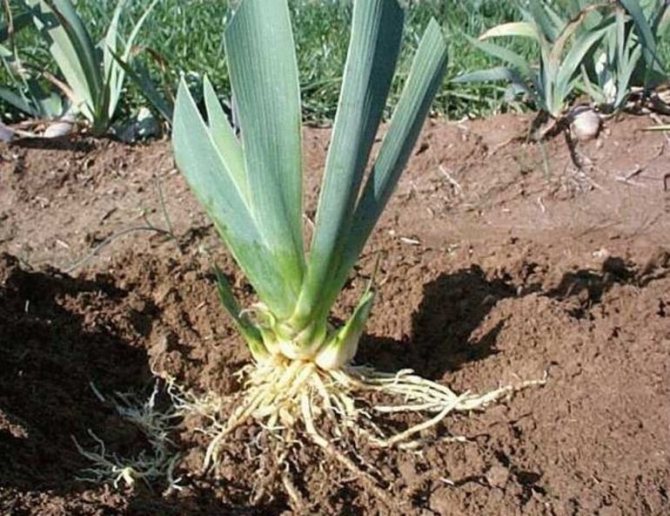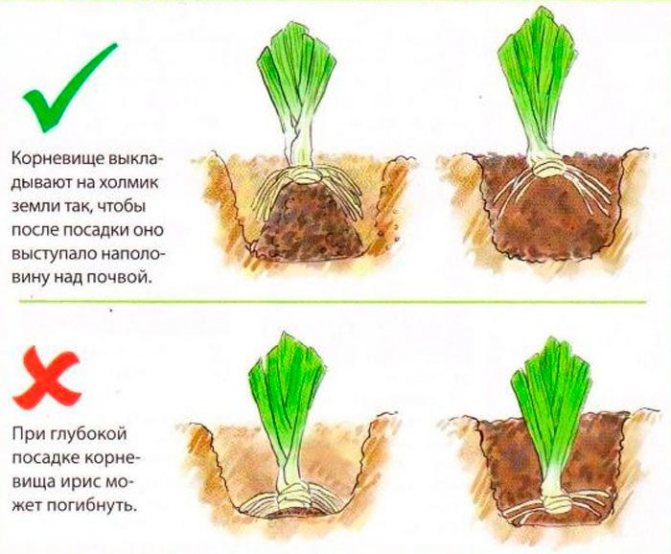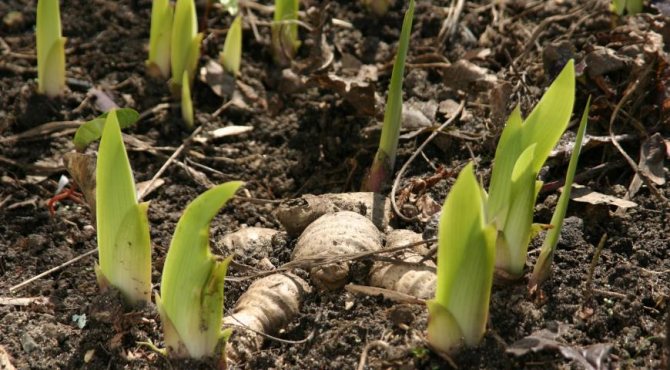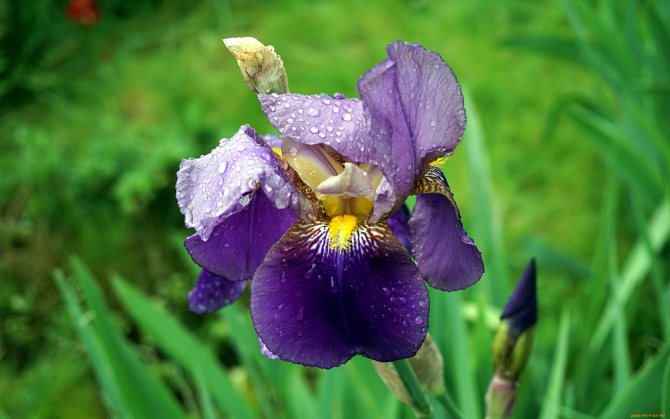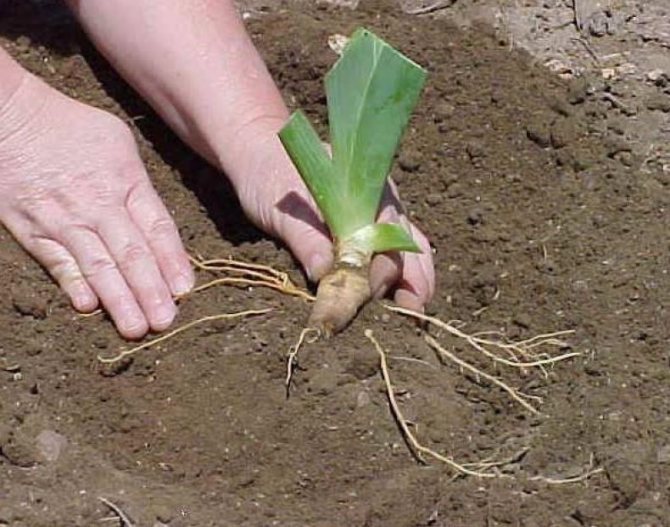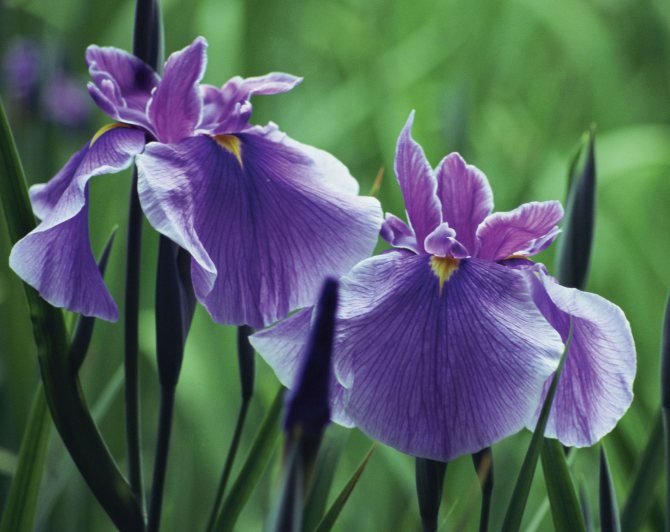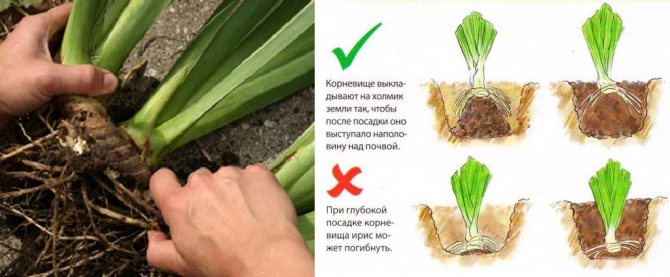One of the first perennials blossoming in the country is multi-colored irises. What kinds of varieties you will not see on the plots: lilac, yellow, white, double and smooth, similar to huge tropical butterflies! Irises do not bloom for long - about two weeks, but even after flowering they decorate flower beds thanks to decorative leaves. Bushes have a tendency to overgrow, so they need to be periodically separated and replanted. The division can be carried out in summer and spring - each season has its own pros and cons.
- 2 Why do you need to transplant irises
- 3 How to choose the right time for a transplant
3.1 Summer transfer
3.1.1 Video: transplanting irises in summer
- 4.1 Video: dividing and transplanting irises
- 6.1 Video: planting bulbous irises
A little about irises and their varieties
Iris is a perennial plant of the Iris family, which gets its name from the Greek goddess of the rainbow Iris. It is a bush with a powerful rosette of dense, dagger-like leaves of a bright green color, a high annual peduncle stem, on which one or three large flowers with 6 petals bloom: two of them are raised up and form a kind of dome, and three are curved outward ... The leaves of these perennials are covered with a wax coating.
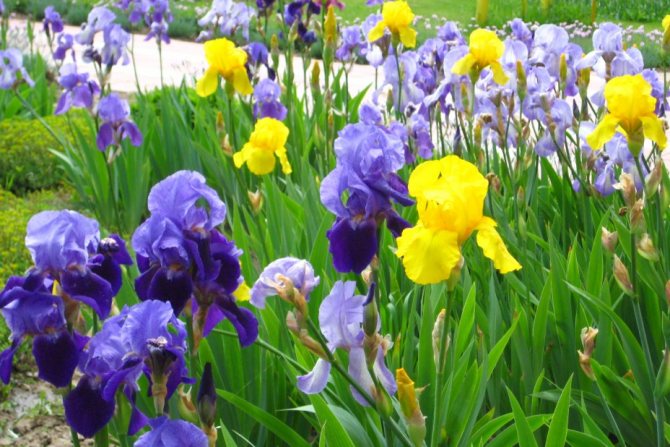
Irises are a large group of early flowering perennials with a variety of colors
Flowers are unpretentious to care for, winter well in the conditions of Russian frosts, they feel good in hot and dry summers. They love light, sandy loam, slightly alkaline soils, and on acidic soils they can bloom weakly or not bloom at all. They easily tolerate a transplant and take root well in a new flower bed. Flowering lasts from 12 to 20 days, depending on the variety.
Two- and three-year-old irises bloom most magnificently.
Irises are bulbous and rhizome. Interestingly, neither the rhizome nor the iris bulb are actually roots - they are just thickenings on the shoots.
General information


Now many growers are trying not only to grow different types of irises, but also to plan their planting in accordance with the flowering periods, plant height, and care rules. These features must be known and applied when creating a decorative landscape.
It is iris that is often used in the formation of flower beds for the reason that even after flowering, it continues to decorate the entire site. The unusual shape of the leaves and the rich green color involuntarily attract the eye until the coldest days. If you transplant irises in the fall, then in the spring you can admire your work, which will appear in all its glory.
The advantage of iris over other garden flowers is a wide range of colors: from snow-white to black. The aroma also ranges from delicate vanilla caramel to chocolate. And although they do not require careful maintenance, replanting them is still necessary.
Why do you need to transplant irises
The rhizomes of the iris tend to grow: every year one or two new divisions with a length of 10 to 12 centimeters appear. Since irises are most often planted in a heap or in a row, the rhizomes take up more and more space, the bush ceases to have enough food.


If you do not replant irises, they will grow too thick and degenerate.
As a result, the plant degenerates:
- flowers are formed less and less, they become small;
- the roots may be on the surface of the earth, and the leaves may dry out;
- the immunity of the iris weakens, an unpretentious plant may start to hurt.
Therefore, beautiful perennials need to be transplanted at least once every five to six years.
About leaving
Gardeners liked these flowers not only for their beauty and pleasant aroma, but also for their unpretentiousness. They do not require special care, tolerate droughts, do not like stagnant water and feel comfortable in flower beds in winter, despite the fact that the rhizomes are practically on the surface.
Weeding and loosening the beds with irises are carried out as needed. Iris whales do not need special nutrition - fertilizers are applied once a year, even on frozen ground after the snow melts. Additional feeding will be needed if the plant slows down in growth. But this usually occurs from the 3rd year, when the rhizomes grow significantly.
If you keep these flowers in one place for a long time, they not only become smaller, but also lose their quality, and also begin to hurt. Therefore, the optimal time for transplanting irises is from the 4th year of life. Otherwise, the old (dying) rhizomes will clog the young, preventing them from developing.
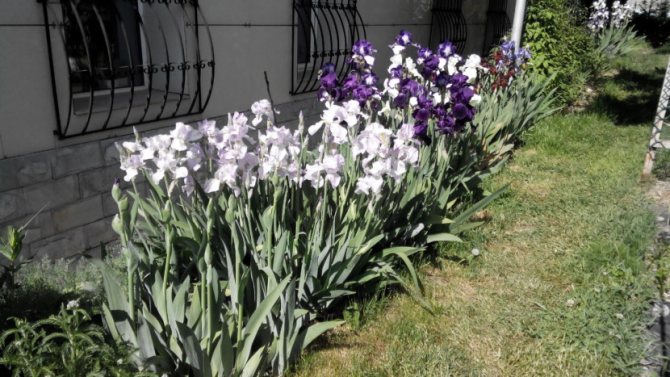

Irises care
How to choose the right time for a transplant
The dividing and transplanting times of irises may vary. The main rule for a summer transplant is that two weeks should pass after flowering.
Different varieties of irises bloom at different times:
- in May (Barna, Victor, Galleon Gold);
- in June (Akmulla, Bereginya, Galatea);
- in July (Altai Snow Maiden, Bliki).
Therefore, the timing of their transplant is different.


Different varieties of irises bloom from mid-May to mid-June
They also depend on the growing region. For example, in the south of Russia, you can transplant irises a month later. Blooming irises cannot be transplanted, since the plant spends a lot of energy and, for all its unpretentiousness, may not take root in a new place.
After flowering, perennial leaves remain green almost until the end of summer and look decorative. During this time, the plant accumulates strength for wintering.


Thanks to the beautiful leaves, irises retain their decorative effect even after flowering.
Summer transfer
When the last flowers are blooming, the plant goes into hibernation. This time is favorable for transplanting and dividing the bush. For different varieties, this can be from early July to mid-August. The perennial will have time to take root well in a new place and may bloom next year.
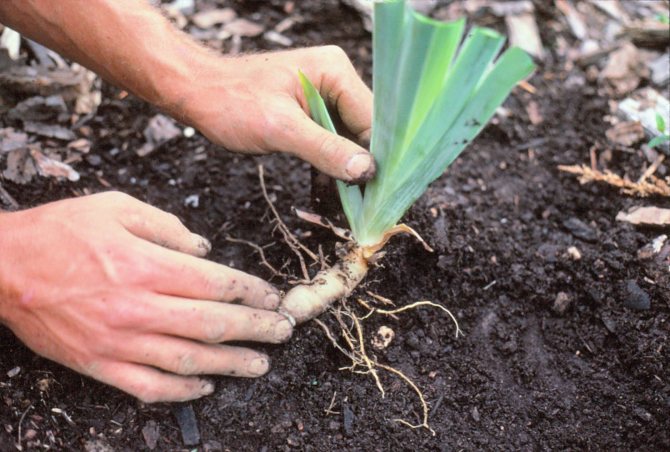

Iris transplanted in summer will not necessarily bloom next year.
You cannot transplant later, since in September the irises lay inflorescences for the next year (so-called replacement buds develop in the axils of dried leaves) and grow new roots. You cannot cut the leaves during this period, since if you cut out the foliage ahead of time, the process of growing new shoots will begin, and the iris cannot be planted.
Video: transplanting irises in summer
When I was a beginner gardener and did not know much about flowers, in August a neighbor gave me rhizomes of irises, telling me how to plant them. I did everything according to her instructions, but the next year there were no flowers in the flower bed, only numerous sharp leaves. But a year later, the irises were pleased with the active flowering.
Spring transplant
In the spring, in May, young stems will form from the replacement buds, on which flower buds and the flowers themselves will develop. At this time, the bush is strong enough and developed and it can be divided into two or more parts, depending on the degree of growth of the rhizomes. Usually a cut with 7–8 leaves is cut off and transplanted to a new location. With proper care, such a bush will bloom this summer.
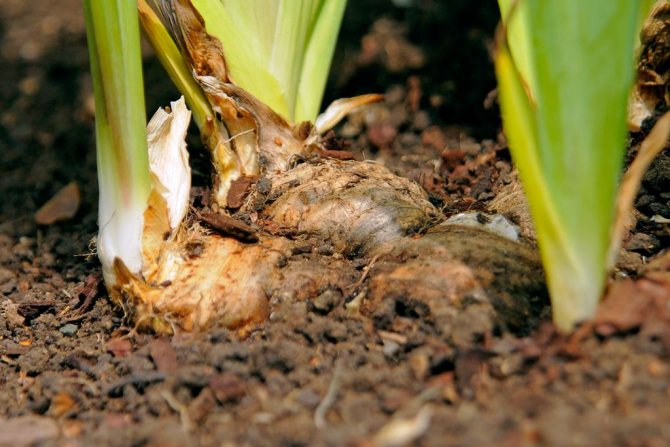

In the spring, usually cut off from the iris with 7-8 leaves for transplanting to a new place
Features of the growing season of irises
Annual transplanting of irises in the fall is not required, but once every 3-4 years it is necessary to plant the plant in order to rid it of old roots. New roots will grow quickly. Without a transplant, they cease to bloom violently already in the 5th year. This is especially important for varietal flowers.


Irises bloom from the second half of May to the end of June, depending on the variety and regional affiliation. But with the end of flowering, their growing season does not end.
The growing season of irises throughout the year is divided into several stages:
- With the onset of spring, as soon as the snow melts, they rapidly build up the aerial part of the plant. Judge for yourself, in just a month and a half, from the first shoots, they turn into lush green bushes and the first buds appear on them. It is for this reason that many growers advise against transplanting irises in the spring. Indeed, for rapid growth during this period, they need a well-rooted underground part of the plant. Planting irises in autumn is more preferable.
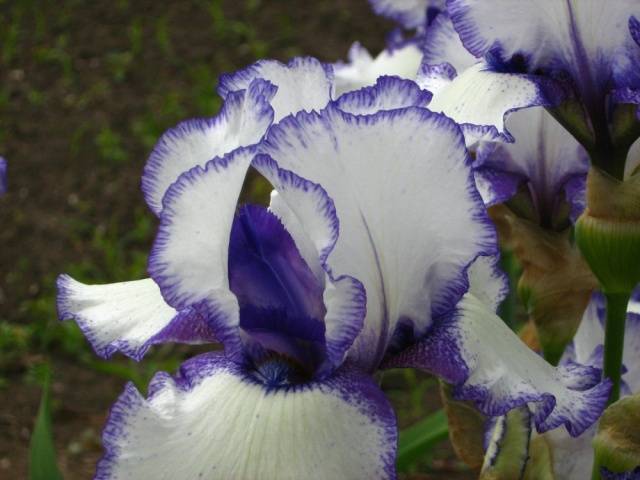

- At the end of the flowering phase in early July, active development of the root system begins. During this period, new links are formed, on which young buds will appear by autumn. They will bloom next spring. Therefore, if you decide to transplant irises, it is important to catch the moment when the new links have grown, but there are no buds yet. Summer iris transplantation is dangerous in that the newly formed delicate buds can be easily damaged. Despite numerous tips, it is still not worth making a transplant until mid-August.


- By the second half of August, the root system of irises ends the phase of active development. Young buds formed on the links have grown stronger and are perfectly visible to the naked eye. This factor is of no small importance when dividing a large bush into several small ones. From now until mid-October is the ideal time to transplant and plant irises in the fall.
It's no secret that irises bloom magnificently if ideal conditions are created for them and the root system is well developed. Since the flowering period begins at the end of spring, it is quite natural that they need to create such conditions in the fall so that by this time the roots are strong and well rooted.


Comment! Delenka, fan, layering, scapula - this is how the iris planting unit is called. This is a single link of the rhizome, the length of which is 3 - 5 cm, and the diameter is 1 - 2 cm.
If you decide to transplant irises in the spring, then most of the time and effort of the plant will be spent on strengthening and rooting the root system. It's useless to wait for flowers this year.
Subject to the terms and rules for transplanting irises in the fall, in one season a bush will grow from a small seedling, which next year will give good links that can later be planted.
Some features of irises
Knowing some of the preferences of these plants, you will find that it is not difficult to grow them.


- Irises are very demanding on such indicators as soil moisture. Therefore, too frequent watering or groundwater located close to the surface can cause root rot. To prevent this from happening, flower growers are advised to raise the bed for planting 10-15 cm above ground level.
- Irises do not like watering too often: it is enough to water them 2-3 times a week in dry weather. The rest of the time, you need to focus on the state of the soil at the base of the aboveground part of the plant. If the ground is dry, then the flowers require moisture. And if the soil is moist and soft, then watering is not required.
- The roots are always located closer to the surface of the earth. This feature must be taken into account when planting and caring for irises. Weeds must be removed manually in a timely manner. You can damage the roots with a chopper or flat cutter.
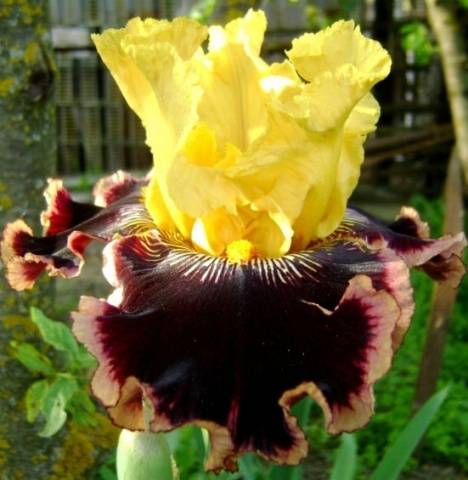

When and how to transplant irises correctly, you can learn from the following video:
Preparing the soil for transplanting
Before you start transplanting irises in the fall, you need to choose the right place for the future flower garden. The composition of the soil, groundwater, illumination strongly affect even such picky flowers.
Irises are very fond of sunlight. Especially in the first half of the day, the maximum amount of sun should fall on the flower bed. Remember where the snow melts fastest in the spring. There you need to plant irises in the fall. It will be the perfect spot for an iris paradise.
It is desirable that strong winds also bypass the place for transplanting irises.


Unlike other garden flowers, irises like loamy, slightly acidic soil. If the ground is too dense and heavy, sand should be sprinkled over the surface before digging. If the soil is light and sandy, add a little clay. You can add a small amount of well-rotted humus and ash to the soil, provided that the soil is too acidic. It will be useful to add potash fertilizers and superphosphates to the soil before replanting irises in the fall.
Important! Fertilizers containing nitrogen stimulate the rapid growth of green mass. Therefore, it is advisable to feed the flowers with them in early spring before the onset of the budding phase.
Growth stimulants when transplanting irises in autumn or spring are not recommended to be introduced into the ground. In the fall, they will not allow the roots to fully prepare for the onset of winter. And in the spring, the root system, having given all its strength to the leaves, will become weak and defenseless.
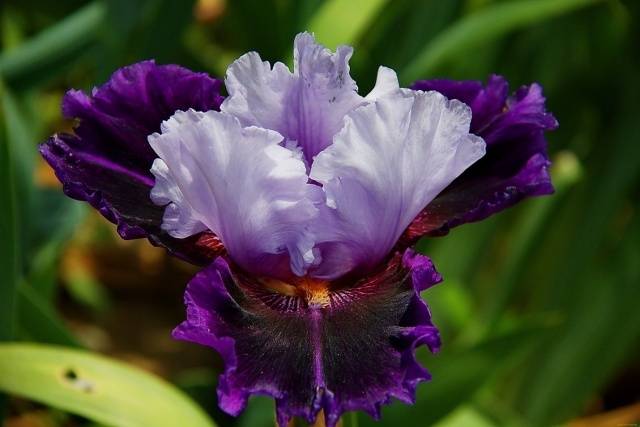

It is advisable to complete all preparatory work approximately 7 - 10 days before the start of transplanting irises in the fall. In order for the soil to compact and take on the desired consistency, the area intended for planting needs to be watered abundantly 3-4 times. During this period, the loosened and fertilized soil will compact and settle. Now you can plant irises in the prepared area.
Preparation of planting material
When planning planting works, flower growers are guided not only by such a factor as the season. The main signal when it is necessary to transplant irises in the fall, so that they better take root and take root, is the state of the foliage. As soon as the tops of the leaves begin to turn yellow, you must immediately start transplanting.


Advice! In order not to confuse the planted irises, you can inscribe the variety name with a marker on the rest of the sheet.
An iris bush that needs an emergency transplant, it is advisable not to water or fertilize 2 - 3 weeks before planting. It is necessary to remove the rhizome from the soil only with a pitchfork and with great care. To do this, stepping back from the base by 20 - 25 cm, you must first dig in the iris around the perimeter. And then carefully remove the roots from the ground. After shaking off the rest of the soil, dry the planting material well. After drying, you can start dividing the main iris bush into small divisions.


At this stage, it is important to know how to properly separate small layers. It is highly undesirable to divide the bush for subsequent planting by hand, without special tools. So, you can not only break the roots into links incorrectly, but also damage most of the young buds. All seed will be hopelessly spoiled and unusable. Separation must be done with a sharp, clean knife. When cutting, it is important to pay attention to at least one “fan”, several young buds and a piece of root up to 10 cm long on each separated root. The cut site should be immediately treated with ash, thus carrying out a kind of disinfection.
Too long side roots of irises need to be trimmed. Their length should be between 5 and 10 cm. Longer absorbent roots will interfere with transplanting irises.
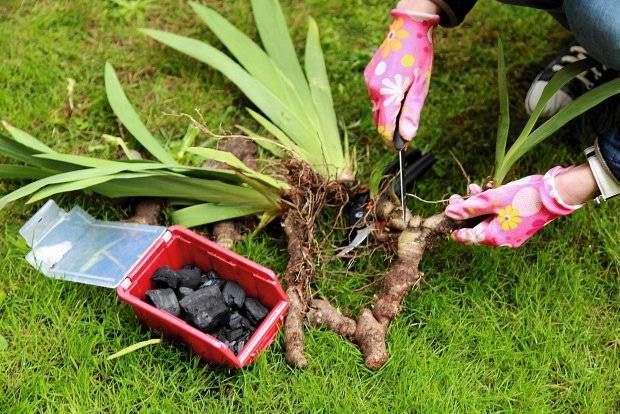

Before planting the seed in the fall in the prepared soil, it should be treated with potassium permanganate (light pink solution) or fugicide. In potassium permanganate, the roots are kept for about 20 - 30 minutes, in a disinfecting solution - according to the instructions on the package.
Important! Recently acquired rhizomes are also subject to compulsory drying and disinfection. Even if they were bought by you in specialized stores or were delivered by mail.
Iris leaves should be cut by 2/3. The shape of the cut should resemble the roof of a house. It is undesirable to completely cut off the leaves, since the process of photosynthesis takes place in them until the very frost. Irises of different varieties should be marked or signed.


Transplanting irises in autumn
The process of planting irises in autumn is very simple and consists of only three stages. The main thing is to have the desire and a small section of pre-prepared soil. It is advisable to plant flowers in dry weather.
- The planting hole for irises should not exceed 10-12 cm in depth. In the middle of the groove, you need to form a small mound, 2-3 cm high.
- A trimmed cut is placed on it. It is important that the absorbent roots go down the hill to the bottom of the planting pit. Spread out all the roots gently. Do not allow them to bend.
- And the last thing - cover the roots with earth. At the same time, keep in mind that when watering, the soil will settle by 1-2 cm. The root collar and a small part of the main root after shrinkage should be located above the ground.
Autumn work on transplanting irises ends as usual - with moderate watering.


As you can see, there is nothing difficult in transplanting irises in the fall. The main thing is to track the plants for two weeks after the end of planting work. Each planted division should stand strictly upright, not leaning to the side.
The distance between planted flowers can vary from 10 cm to 35 cm. Why is there such a difference? When determining the distance you need, you need to consider:
- Plant variety.
- The height of the flowers. Low-growing varieties can be planted closer to each other, tall ones - as far as possible.
- The frequency of transfers. If within 3 - 5 years transplanting irises is not included in your plans, then it is advisable to increase the distance between the plots.
The author of the video will tell you about the basic rules of planting and caring for irises for novice gardeners:
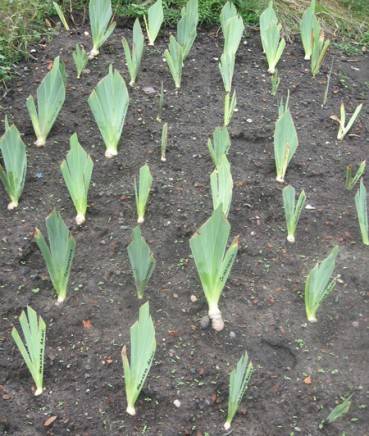

Care for irises after autumn planting
Provided that the autumn is warm and does not indulge in heavy rains, the planted irises should be watered after three to four days.
Caring for irises after planting in early autumn consists in weeding in time. It is important to consider that the roots are shallow, and in order not to hurt them, it is better to remove the weeds by hand.
After transplanting irises in the fall, it is important to keep an eye on the declining air temperature. When frost approaches, it is advisable to mulch them with dry leaves, peat or spruce branches. In the Siberian region, mulching is mandatory. As soon as possible, as soon as the snow melts and there is no threat of severe morning frosts, the mulching layer must be removed. More care for irises in the fall after transplanting is not required. Mother Nature will do the rest. The first rays of spring will warm the roots and soon the first green arrows will appear on your site.


Important! When replanting irises, the soil should not be fertilized with manure. Not only do they dislike this type of fertilizer, there is a high probability of burning the root system and root collar.
Subject to the simple rules of planting and leaving, irises are gaining color in the spring. During the summer, they build up an excellent root system. But you can divide and plant the root only in the second year after planting.
Despite the fact that irises are unpretentious in maintenance, they should still be replanted every 3-5 years. Thus, you will save them from the degeneration of varietal traits.Moreover, adherence to planting dates will keep the root system in excellent condition. And thanks to her, at the end of spring, irises will delight you with lush flowering and delicate aroma.


Caring for transplanted flowers
Water immediately after transplanting. Then watering will not be required so often - after one to one and a half weeks and then with the same interval. If the bushes are planted in spring or summer, you don't need to do anything else with them, just cut off the leaves that have grown by the end of summer and fertilize around the roots with superphosphate before the cold weather.
It is necessary to loosen and remove weeds in a flower bed around irises very carefully, since their roots are located close to the surface of the earth.
After the autumn planting before winter, irises are mulched with peat, humus or covering material and are also fed with superphosphate.
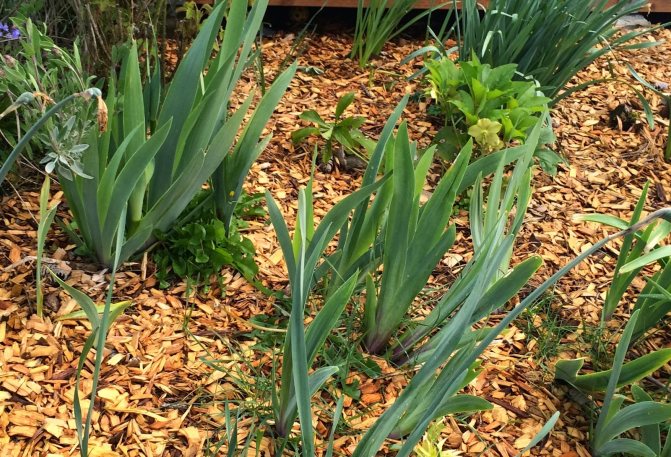

Before winter, irises are mulched so that rhizomes close to the ground do not freeze
How to plant irises in spring
When to prune irises
In the spring, planting material bought in a store or overwintered in a shelter needs to be treated with a growth stimulant. After winter, the seedlings may be too weak, and this will only increase the chances of successful rooting.
Additional Information! Ecogel and Zircon have shown themselves well as growth stimulants.
Roots that are too long need careful pruning. The rotten parts of the rhizomes are also removed.
Step-by-step disembarkation process:
- A small hole is dug into which a little sand is poured into a hillock.
- A rhizome is placed horizontally in the hole, which must be straightened.
- Almost the entire hole is covered with earth, but the upper part of the rhizome must be left on the surface to prevent the flower from rotting. A new hole is made at a distance of 40-50 cm from the previous one.
- The planted plant is watered.


Zircon
Transplanting bulbous irises
In Russian gardens, rhizome irises are more common, but bulbous ones are also found. Transplanting this variety is very similar to transplanting other similar plants (for example, tulips).
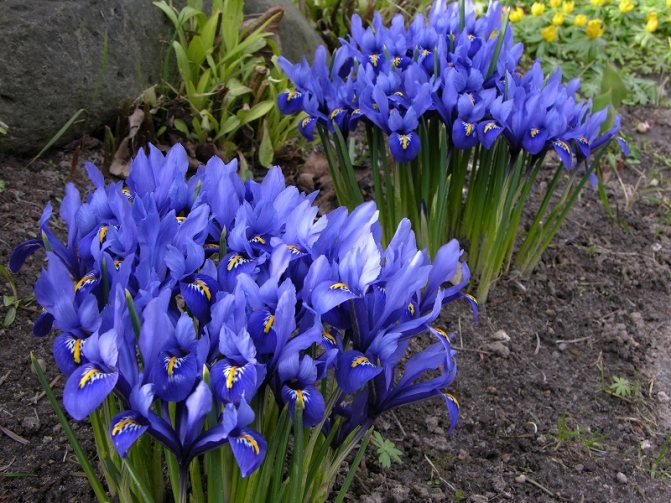

Bulbous irises are often planted in clusters
Procedure:
- The bulbs are dug up two weeks after flowering.
- Soak for an hour in a slightly pink solution of potassium permanganate.
- Dry in a well-ventilated area (but not in the open sun).
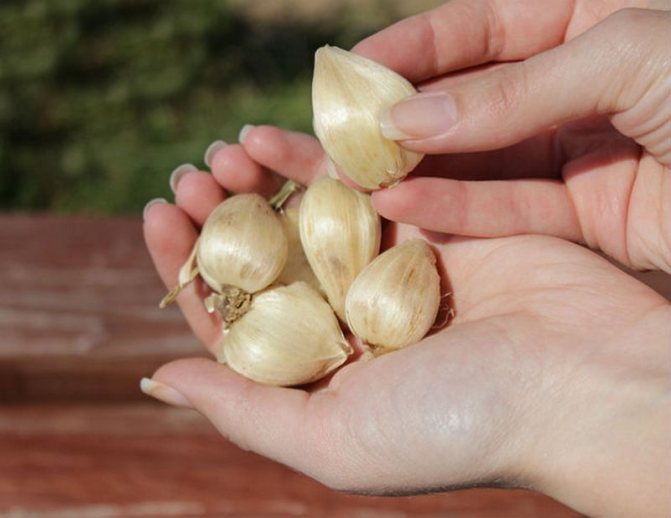

Iris bulbs do not tolerate waterlogging at all
Planting material is stored until the end of August or September in a dark place, then planted in the ground to a depth equal to the height of three bulbs, and at a distance of 10-15 cm. It is not necessary to water specially bulbous irises, as they do not tolerate even slight waterlogging and can rot. There will be enough rain and morning dew.
Prevention of diseases during transplantation
It is not difficult to prevent the appearance of iris diseases during autumn transplantation. First of all, it is necessary to choose areas where there have not been the smallest irises over the past 5 years. Rhizome treatment with ash and Maxim should be mandatory.


If there is a risk that the soil on the site chosen for transplantation may become infected, it must be spilled with a strong solution of manganese. Such processing should be carried out no later than 7 days before the planting of irises.
Autumn transplanting of irises will allow you to get magnificent flower beds in your garden, delighting with their beauty from year to year. Choosing from a variety of varieties, the florist will create his own unique collection, which will be preserved and increased with proper plant care.
Why irises don't bloom
If irises are improperly taken care of, then they may not bloom. So why don't irises bloom? There are several reasons for this. The main ones include:
- Incorrect fit.
- Lack of space. After 5 years, the plants grow so much that they must be planted.
- Lack of light - in this case, transplanting irises becomes a necessity.
- Lack of pest control.
- Bad soil that is not at all suitable for these species.
- Failure to comply with wintering rules.
Attention! Now that everything is known about transplanting irises to another place in the summer, as well as about the peculiarities of their care and cultivation, it remains only to acquire the shoots of these excellent plants and enjoy their flowering in your country house.


